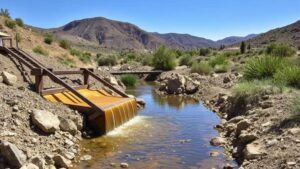Techniques for Processing Gold-Rich Sediments in Fast-Moving Rivers
Techniques for Processing Gold-Rich Sediments in Fast-Moving Rivers
Extracting gold from sediments in fast-moving rivers presents unique challenges and opportunities for prospectors and mining operations. Understanding the dynamics of river sediment transport and employing the correct processing techniques is essential for maximizing gold recovery. This article explores various methodologies and their practical applications in effective gold extraction.
The Nature of Gold-Rich Sediments
Gold is often found in alluvial deposits, which are materials such as sand, gravel, and silt that have been deposited by water. In fast-moving rivers, these sediments can accumulate in specific areas, referred to as pay streaks. The characteristics of these sediments often dictate the processing methods employed. The grain size, density, and sorting of the sediment play crucial roles in recovery rates.
Key Processing Techniques
Several techniques are utilized to process gold-rich sediments effectively. Here are some of the most common methods:
- Panning: One of the simplest and most traditional methods, panning involves scooping sediment into a pan, followed by various shaking and swirling motions to allow gold, being denser, to settle at the bottom. This technique is often used for small-scale prospecting.
- Sluicing: A sluice box allows for larger quantities of material to be processed. Water is directed through a long, sloped box lined with riffles that trap gold particles as sediment is washed away. This method is widely used in both recreational and commercial mining.
- Dredging: In areas where sediments are deep and extensive, dredging may be employed. This involves the use of a suction or mechanical dredger to extract sediment from the riverbed, which is then processed through sluices or other recovery systems. Dredging can handle larger volumes but often requires permits and environmental assessments.
- Highbanking: A hybrid technique that combines elements of both sluicing and dredging, highbanking involves the use of a pump to direct water over a sluice box while materials are fed into it from an elevated position. This method allows for more controlled processing and can be conducted away from the water source.
Challenges in Gold Processing
Despite the effectiveness of various methods, several challenges can affect gold recovery in fast-moving rivers:
- Water Flow: Rapid water flow can wash away lighter sediments, making it difficult to isolate gold particles. Adjusting techniques based on water speed is crucial for efficient recovery.
- Environmental Regulations: Regulatory requirements can limit certain practices, particularly dredging. Understanding local laws is imperative before commencing any gold extraction activities.
- Equipment Durability: The harsh environments of fast-moving rivers can wear down equipment quickly. Investing in high-quality, durable gear is essential for consistent processing.
Case Studies
Several successful operations exemplify effective gold processing in fast-moving rivers:
In the Yukon, Canada, the use of floating sluice systems has led to increased recovery rates, enabling miners to capitalize on the natural flow of water while working efficiently on multiple locations along the river. Such systems have demonstrated the viability of semi-mechanized mining in accessible waterways.
In contrast, regions like the Amazon basin face more stringent regulations and environmental concerns. Here, the emphasis has shifted toward eco-friendly processing methods, utilizing gravity concentration systems that minimize ecological impact. These innovations demonstrate a growing trend towards sustainable mining practices.
Conclusion
Processing gold-rich sediments in fast-moving rivers requires a nuanced understanding of both the natural environment and the appropriate technology. Techniques such as panning, sluicing, dredging, and highbanking offer various advantages and face specific challenges. By adapting methods to the conditions of each river and remaining compliant with regulations, miners can significantly enhance recovery rates while minimizing ecological impact.
Actionable Takeaways
- Evaluate specific river conditions before selecting a processing technique to optimize recovery.
- Stay informed about local regulations and best practices to ensure environmentally responsible mining.
- Invest in durable equipment suited to the challenges of fast-moving river environments.

